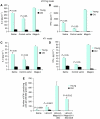Vaccination with Mage-b DNA induces CD8 T-cell responses at young but not old age in mice with metastatic breast cancer
- PMID: 19826426
- PMCID: PMC2756562
- DOI: 10.1038/sj.bjc.6605329
Vaccination with Mage-b DNA induces CD8 T-cell responses at young but not old age in mice with metastatic breast cancer
Abstract
Background: Elderly individuals react less efficiently to vaccines than do adults, mainly because of T-cell unresponsiveness. In this study, we analysed whether tumour-associated antigen (TAA)-specific CD8 T-cell responses could be induced by vaccination in old mice with metastatic breast cancer.
Methods: The effect of pcDNA-3.1- and Listeria-based vaccines, expressing TAA Mage-b, on Mage-b-specific immune responses was tested in spleens and draining lymph nodes (LNs) of mild (4TO7cg) and aggressive (4T1) syngeneic metastatic mouse breast tumour models at young (3 months) and old (20 months) age.
Results: Interferon gamma and interleukin-2 levels increased significantly in draining LNs and spleens of Mage-b-vaccinated mice compared with those in control groups at young but not old age in both mouse tumour models. A significant increase was observed in the number of IFNgamma-producing Mage-b-specific CD8 T cells after Mage-b vaccination in the 4T1 model at young but not old age. This correlated with a reduced protective effect of Mage-b vaccination against metastatic breast cancer at old compared with young age.
Conclusions: The absence of CD8 T-cell responses after Mage-b vaccination and the accompanying reduced protection against metastatic breast cancer in old compared with young mice point towards the need for tailoring cancer vaccination to older age.
Figures






References
-
- Anisimov VN (2001) Life span extension and cancer risks: myths and reality. Exp Gerontol 36: 1101–1136 - PubMed
-
- Aslakson CJ, Miller FR (1992) Selective events in the metastatic process defined by analysis of the sequential dissemination of subpopulations of a mouse mammary tumor. Cancer Res 52: 1399–1405 - PubMed
-
- Baron-Bodo V, Doceur P, Levebre ML (2005) Anti-tumor properties of human-activated macrophages produced in large scale for clinical application. Immunobiology 210: 267–277 - PubMed
-
- Chambers RS, Johnston SA (2003) High-level generation of polyclonal antibodies by genetic immunization. Nat Biotechnol 21: 1088–1092 - PubMed
-
- Ershler WB (1984) The aggressiveness of neoplasms with age. Geriatrics 42: 99–103 - PubMed
Publication types
MeSH terms
Substances
Grants and funding
LinkOut - more resources
Full Text Sources
Medical
Research Materials

